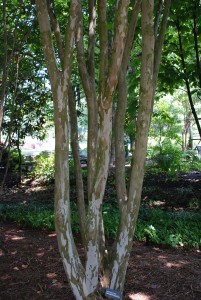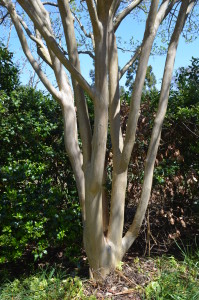The flowers of crape myrtles are a wonderful floral treat in the summer months, several exhibit gorgeous exfoliating bark. Some also show off autumn foliage colors. Here are the best ten species and cultivars of crape myrtles noted for their exfoliating bark.
Lagerstroemia hybrids (L. indica x L. fauriei)
Hopi – 8-10 feet semi-dwarf shrub; gray brown exfoliating bark; medium pink flowers.
Tonto –8-10 feet multi-stemmed large shrub; light cream bark; dark fuchsia flowers.
Acoma –11-15 feet high shrub-like habit; cream white bark; clear white flowers
Lipan – 11-15 feet high multi-stem small tree; near white bark; medium lavender flowers.
Osage –11-15 feet high shrub-like habit; chestnut-brown bark; clear pink flowers
Apalachee – 16-20 feet height; cinnamon -brown bark; lavender blossoms
Miami –21-25 feet; dark brown inner bark; dark pink flowers
Tuscarora – 21-25 feet tall; light brown exfoliating bark and deep coral pink flowers.
Muskogee – 30 feet tall; light gray-brown bark; light lavender flowers
Natchez – 30-33 feet high; dull white flowers; deep cinnamon-brown bark
Select Acoma or Lipan for their near white to cream colored bark, an alternative in the South (USDA hardiness zones 7 thru 9) where white bark birches (Betula spp.) do not thrive in warmer environs.
L. fauriei selections:
‘Townhouse’ – 40 foot high; small snowy white flowers; dark chocolate bark.
‘Fantasy’ – 50 feet high; small snowy white flowers; flaking cinnamon brown bark.
Best locations to plant crape myrtles are in full sun and in moist rich soils. They tolerate poor soils if they’re adequately drained. From the list above, select the cultivar(s) that will fit the landscape space. In urban areas plant them along boulevards, in parking lots, and in small pavement cutouts. If soil area is limited, provided with irrigation until plant (s) are well established. They tolerate clay and alkaline soil well.
Insect pests are few, but some cultivars of crape myrtles are susceptible to powdery mildew damage, especially in shady or areas with poor air circulation. Many USDA cultivars are resistant to powdery mildew and aphids. Crape myrtle scale is a new insect pest that is slowly moving northward from southern areas of the U.S.



 Posted in
Posted in 
